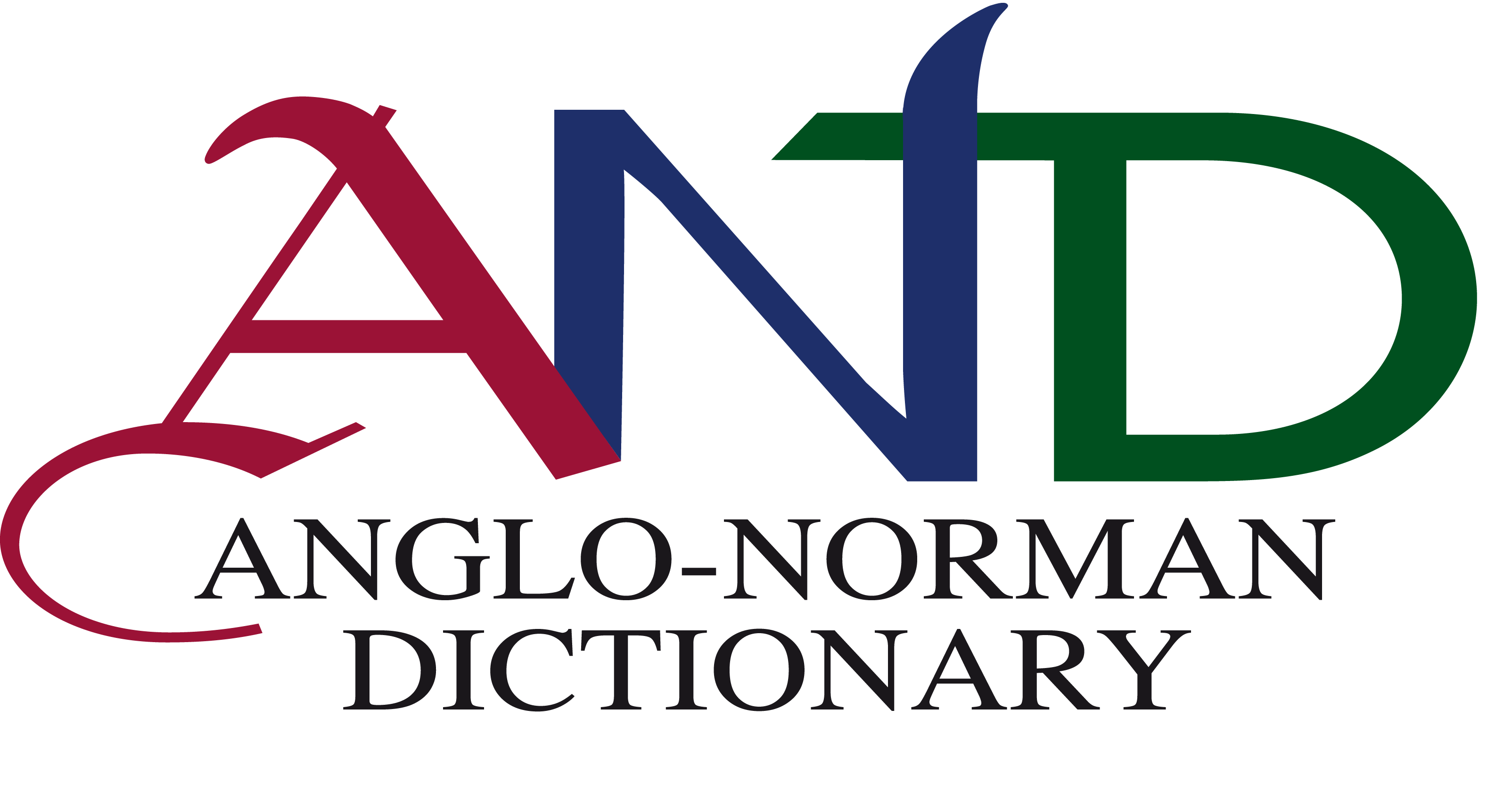Linguistic Ecology: Language Change as Social Fact
A guest blogpost by Dr. Emily Reed (University of Sheffield), who visited the Anglo-Norman Dictionary project in February-March 2020 through an AHRC bursary
‘Language shift […] is a social fact with linguistic implications’ (Thomason and Kaufman 1988: 212).
Language is a tool that we use to produce meaning. As such, it can only do what we enable it to do. Indeed, when wielded with skill, language can invest its user with much power. It can alter the usual course of events, it can change minds, and it can build a speaker’s reputation. A speaker can do this by playing to concepts that carry social currency: ‘politeness’, ‘aesthetics’, ‘eloquence’. Such labels might carry additional significances and consequences. For instance, ‘eloquence’ may be perceived as a marker of class, and depending on the listener, that may prejudice them in the speaker’s favour (or not).
Of course, language is also the possession of the listener(s), who engage in a discursive back-and-forth with the speaker(s), one that constantly calls upon external, social, and political factors.
This view of language recalls Einar Haugen’s notion of ‘linguistic ecology’, theorised in reaction against linguistic thought that saw speech communities as incidental to the business of studying language.
The true environment of a language is the society that uses it as one of its codes. Language exists only in the minds of its users, and it only functions in relating these users to one another and to nature, i.e., their social and natural environment […] The ecology of a language is determined primarily by those who learn it, use it, and transmit it to others. (Haugen 1972: 325)
In a linguistic ecological model, it is impossible to understand language without understanding its speakers. Here, language is considered as an organism; the speakers, the environment. Speakers form the conditions under which facets of language change, thrive, or die. The key to understanding language is understanding this ecology of actors as dynamic, interactive, and made up of change that begets further change.
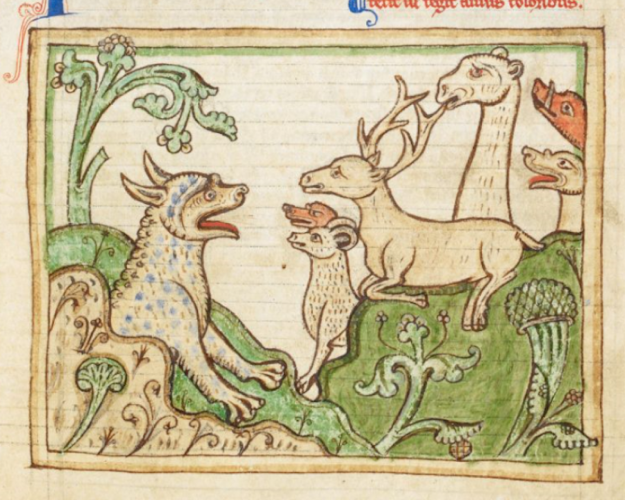
Nature can provide a metaphor for thinking about language (Harley 3244 f. 37r)
This way of seeing language is echoed by Halliday’s ‘social semiotic’ in which the view was that ‘[l]anguage is as it is because of the functions it has evolved to serve in people’s lives’ (1978:4). These functions are interpersonal (language facilitates relationships between people) and ideational (language represents a speaker’s ideas about the world). Language also serves a textual function: a speaker may commit the interpersonal and the ideational into textual form, broadly defined, thereby linking and declaring them to their context (i.e. wider society [1978:112]).
Closer to home for medievalists, Tim Machan (2005) picks up on the theme of ecology, applying it to Middle English:
[…] Haugen’s early formulation of language ecology retains a good deal of explanatory power. Some aspects of a language ecology in this general, pragmatic sense, like some aspects of a biosystem, may remain relatively constant across time, while others may change rapidly and do so in ways that transform other features of the ecology with them. (Machan 2005: 10)
The above discussion of ‘language-as-object’ forms a backdrop to my own theoretical praxis as a historical pragmatist. My particular interest is in how speech communities imbue linguistic forms with social meanings, and how the language ‘object’ can be made to perform interpersonal and ideational functions. It is not hard to imagine that the period of English/French bilingualism that existed in England during the Middle Ages represented a period of ecological flux, encompassing multiple changes and chain reactions.
In the fields of Anglo Norman and Middle English studies, there has been a great deal of attention on loan words, syntactic change, and phonological shift. All of these can be construed as social and socially-motivated. However, the implication of bilingualism on the pragmatics of Middle English and Anglo Norman is not as widely understood. A broad definition of pragmatics may be found in Crystal (1997: 301):
[Pragmatics is] the study of language from the point of view of users, especially of the choices they make, the constraints they encounter in using language in social interaction and the effects their use of language has on other participants in the act of communication
Additionally, and in line with the notion of linguistic ecology, Mey (2001: 6) states that ‘[p]ragmatics studies the use of language in human communication as determined by the conditions of society’.
In a linguistic ecology, social changes can be seen reflected in the language. These changes may result in enduring shifts in a language or may only come to represent a linguistic flash in the pan.
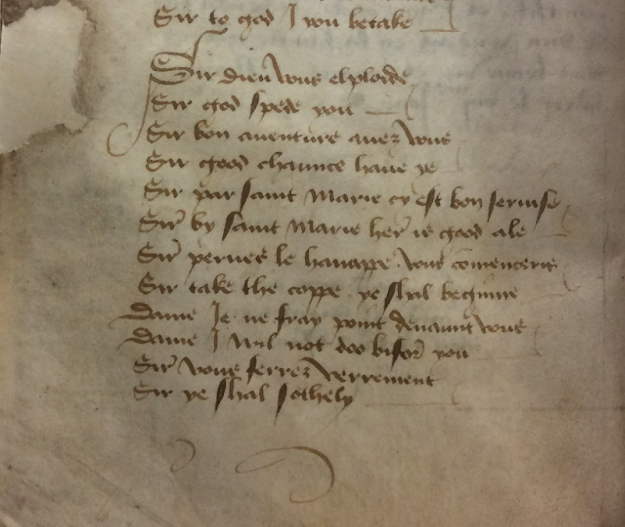
Bilingual Manières de langage fragment from Cambridge University Library Ii.6.17 f.101v
I initially came to Aberystwyth to collect data suggesting a change towards indirect question structures in Anglo Norman and Middle English. Today, we have an inventory of methods available to us when we want to ask for something. These can range from direct forms such as ‘give me that pen’ to less direct forms such as ‘can you please give me that pen?’, ‘would you be able to give me that pen?’ or even ‘I wish I had a pen’. These methods all exist on a continuum between ‘direct’ and ‘indirect’. The fact that such a continuum exists is testament to the social needs of our speech community: to be polite, to be seen as polite, to persuade, to maintain social cohesion (to name but a few). Linguistic indirectness is an innovative area of study, and one that illustrates the social function of language use.
For this blog post I will focus on just one indirect construction: ‘can’ questions. These call upon a speaker or addressee’s ability to do something, but most of us would also recognise this as a form of indirect question. These structures are largely thought to be a modern invention (Culpeper and Archer 2008; Culpeper and Demmen 2011). However, as my data-gathering research at the AND confirmed, these appear in a small number in Middle English and Anglo Norman.
Hoccleve’s Regiment of Princes (1413) presents a borderline case. In the following quotation, an old man asks Hoccleve, when he wants to sleep with his wife:
art þou oght, sonë myn, sensible
In whiche cas þat þou oghtest the for-bere,
And in whiche nat? canst þou to þis answere?
[Are you, my son, at all aware
Of which times you ought to abstain
And of which not? Can you answer this?]
(Regiment of Princes, ll.1566-1568)
The pragmatic mechanics behind the construction ‘can you answer this’, as opposed to simply ‘answer this’, are ambiguous. The old man may be questioning whether Hoccleve is capable of answering his question. However, by its very existence, the question demands an answer. Thus, a second possible pragmatic meaning: ‘I expect an answer, but I am appealing to your ability to answer to avoid imposition’. We can never know the intent represented by this utterance. However, this kind of pragmatic ambiguity provides the conditions for development towards a conventional indirect question structure, should members of the speech community develop the construction that way.
We see can see further examples of ‘can’ questions in Anglo Norman texts:
purroy je ester logge ciens?
[Could I be lodged here?]
(Manières de langage, p.27)
Le roy Porre li dit: ‘Puis tu parler al roy?’
Alisandre respont: ‘Oil, sire, par ma foy.’
‘Porte ly cest bref ou escrit est mon secroy.
[King Porrus says to him ‘Can you speak to the King?’
Alexander responds ‘Yes sir, by my faith.’
‘Take to him this letter where my secret is written’]
(Le Roman de toute Chevalerie, ll.5287-5289)
The latter example, from the Anglo Norman ‘Alexander’, can be seen in another manuscript, Paris BNF Français 24364 f.56r. Both the affirmative response of Alexander, and Porrus’s follow up command suggest that the initial construction ‘puis tu’ should be taken as a form of question (or command) that sits towards the indirect end of the directness continuum. A question remains: why start with a less-direct construction? The choice between direct commands (‘speak to the king’) and less-direct commands (‘can you speak to the king?’) points towards different social needs.

Indirect question structure in BNF Français 24364 f.56r
The former example is also significant, largely due to the text type: dialogues designed to teach conversational French. Because the purpose of these dialogues was to impart a serviceable spoken French, and therefore designed to make the jump from text to speech, it is likely that the language they contain reflects an instructor’s view on what conversational French sounded like (or should sound like). The example is also interesting, as a rare example of asking permission using a ‘can’ question.
The above quotations are a small section of the data gathered on my research trip. This post moreover represents the beginning of enquiry into indirect question structures in both Anglo Norman and Middle English. The presence of these constructions, which can feel disarmingly modern, raises questions: what was the need that saw these appear? I don’t suggest direction from one language to the other, but the fact that this structure appears in both languages suggests the same group of speakers. Do such constructions form part of a register?
Returning, finally, to Machan, the nature of this type of sociolinguistic exploration can be a subtle art:
The history of a language’s social meanings and functions is made more complicated, since it confronts not only the gaps in the historical record but also the fact that much of the linguistic self-consciousness that motivates individuals to write about sociolinguistic issues seems to be even more recent than the advent of print. (Machan 2005: 4)
Machan succinctly encapsulates the nature of the problem: we are often left feeling like we are ‘reading in’ social motivations. Although, this is also a problem shared by linguists studying live speakers. Nevertheless, to do this sensitively, and sensibly, we must corroborate where possible with secondary evidence, commentary, material culture, and historical events. These considerations will inform my next steps in this research.
– Dr. Emily Reed, University of Sheffield
The zeugma in this post is dedicated to my beloved partner, Rod McDonald, who accompanied me to Aberystwyth.

Cockatoo from De Arte Venandi cum Avibus (The Art of Hunting with Birds) MS Pal. Lat. 1071 f.20v
Crystal, David. 1997. The Cambridge Encyclopedia of Language, 2nd ed. Cambridge, New York: CUP.
Culpeper, J. & Archer, D. 2008. Requests and directness in Early Modern English trial proceedings and play-texts, 1640-1760. In: Speech Acts in the History of English. Amsterdam, Philadelphia: John Benjamins. 45-84.
Culpeper, J. & J. Demmen. 2011. ‘Nineteenth-century English politeness: Negative politeness, conventional indirect requests and the rise of the individual self’. Journal of Historical Pragmatics. 12. 49-81
M. A. K. Halliday. 1978. Language as social semiotic: The social interpretation of language and meaning. London: Edward Arnold.
Haugen, E. 1972. The Ecology of Language. in Dil, A. S. (ed) The Ecology of Language: Essays by Einar Haugen. Stanford: Stanford University Press.
Machan, Tim. 2005. English in the Middle Ages. Oxford: OUP.
Mey, Jacob. 2001. Pragmatics. An Introduction. 2nd edn. Oxford: Blackwell.
The Anglo-Norman Prose ‘Brut’ Tradition
[A guest blog post by Dr. Trevor Russell Smith, who visited the Anglo-Norman Dictionary project in 2018 and 2019 through a AHRC bursary]
Latin was the standard language in which one wrote historical literature in England through the fifteenth century, although chronicles, annals, histories, and poems on contemporary and past events were sometimes written in the vernacular. The fourteenth century is commonly seen as the point in which the vernacular of choice shifted from Anglo-Norman French to Middle English. While the latter has received a huge amount of attention over the past few centuries, in no small part due to nationalism and it being more justifiably studied in the classroom, Anglo Norman has been neglected. This is immediately evident when one seeks to examine the historical literature written in the fourteenth century, this supposed transitional period. Gransden, in her widely used reference work, discusses many Latin texts but only three in Anglo Norman (the Anonimalle Chronicle, the French Chronicles of London, and Thomas Gray’s Scalacronica), each of which survives in a single manuscript each.[1] However, Dean and Boulton’s standard resource lists nearly every piece of Anglo-Norman literature and includes a large number of historical writings from this period.[2] A Manual of the Writings in Middle English likewise lists Middle English literature and has a much-cited volume dedicated solely to historical literature.[3] A quick glance at Dean and Boulton, however, will make it evident that most Anglo-Norman historical literature of the fourteenth century remains unpublished, with a few texts in mostly-inaccessible PhD theses of sometimes dubious quality. Accordingly, the bulk of attention on vernacular historical literature in the period is given to writings in Middle English, especially the Middle English Prose Brut. Indeed, the MEPB is often examined over its immediate source, the Anglo-Norman Prose Brut, in no small part due to it being available in a convenient (and now digitised) Early English Text Society edition, but also because the tradition is incredibly complex and not yet fully worked out.[4]
The prose Brut chronicle, narrating Britain’s history from its legendary foundation to the later Middle Ages, was the most widely read secular text in late medieval England. Originally written in French, it soon received continuations and was developed into many versions in English and Latin, thanks to England’s multilingual environment. In total these survive in well over two hundred manuscripts. Its popularity was partly due to its genre defying style, colourful stories, and propagandistic attitude. These traits, however, have driven editors to ignore the Brut in favour of explicitly literary and historical texts. A few manuscripts of the English and Anglo-Norman texts after the Oldest ANPB have been edited, but none are representative and their editors do not examine them in relation to the others (see diagram below).[5] The textual traditions have similarly been studied only in isolation and without proper cross-language examination. Brie knew of only two-thirds of the manuscripts and examined them briefly. Matheson, while he created the standard resource on the English manuscripts, was not interested in the Anglo-Norman or Latin manuscripts and only briefly mentioned them. Marvin has inspected some manuscripts of the Short and Long ANPB texts in detail, but has not performed a comprehensive examination of the textual tradition.[6] Subsequent studies of thematic elements of the Brut texts, such as genealogy, prophecy, and Arthurian stories, have been severely limited due to our poor understanding of the development and dissemination of the Brut.
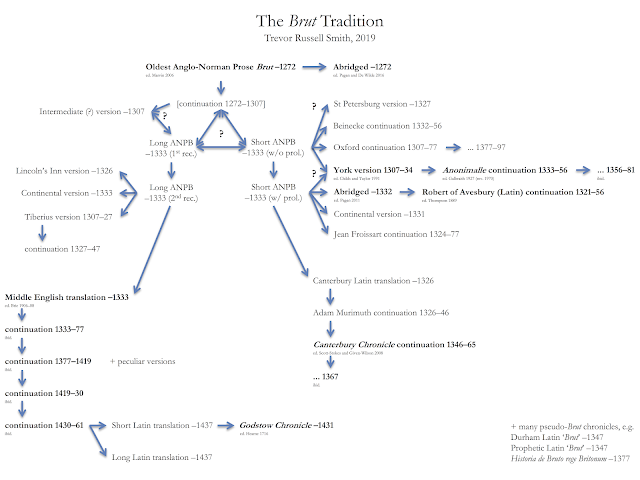
The Brut tradition
*click here for a larger image*
While the development of the various versions of the MEPB are fairly linear, the ANPB’s tradition remains tangled and has yet to be properly worked out. The Oldest ANPB (to 1272) survives in five manuscripts, with another peculiar manuscript not used in Marvin’s edition and an abridged text in a manuscript edited by Pagan and De Wilde. After this, however, it gets difficult. The Short and Long ANPBs (in 16 and 32 manuscripts) both use the Oldest ANPB as their base text through 1272, then have a very similar continuation for 1272–1307, but have independent continuations for 1307–33. The Short ANPB copies over its –1272 text fairly closely, but the Long ANPB makes many changes, most notably the inclusion of prophecies on the reigns of English kings. To make things worse, there are two major recensions of the Long ANPB that have many differences throughout, not only in choice of words or paraphrasing, of which there is plenty. The most troubling element is the 1272–1307 continuation, based on Pierre de Langtoft’s chronicle, as it prevents any sort of linear or otherwise straightforward relationship.[7] Was there an Intermediate ANPB that carried on through 1307 but no longer survives?[8] Was the Short ANPB written through 1333 first and then the writer of the Long ANPB took its text up to 1307 only, modified it, and then added on a continuation of his own to 1333 (or vice versa)? Were the Short and Long ANPBs written independently, with both of them coincidentally drawing on the Oldest ANPB to 1272 and Langtoft for 1272–1307? Or is the tradition more labyrinthine, like that of Piers Plowman?
Because of the more than 50 manuscripts involved, in libraries in the United Kingdom, France, Ireland, Russia, and the United States, scholars have yet to resolve these problems (although they have been happy to offer their theories without much supporting evidence), and therefore no proper critical editions have been produced of the main texts.[9] Even during the great push to create editions in the nineteenth century the ANPB texts were skipped over because they straddled the line between historical and literary text, and were also not in proper continental French or Middle English. These texts have thus, unfortunately, have languished in relative obscurity, despite their clear importance in the period.
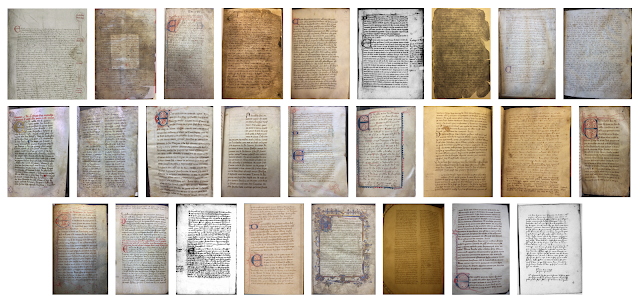
The Short Anglo-Norman Prose Brut manuscripts, from left to right, first row: 1. Cambridge, Corpus Christi College, MS 98; 2. Cambridge, Jesus College, MS Q G 10; 3. Cambridge, University Library, MS Mm I 33; 4. London, British Library, MS Add. 35113; 5. London, British Library, MS Cotton Cleopatra D VII; 6. London, British Library, MS Cotton Domitian A X; 7. London, British Library, MS Cotton Julias A I; 8. New Haven, Yale University Beinecke Library, MS 86; 9. New Haven, Yale University Beinecke Library, MS 405; second row: 10. Oxford, Corpus Christi College, MS 78; 11. Oxford, Corpus Christi College, MS 293A; 12. Cambridge, Trinity College, MS R VII 14; 13. Cambridge, University Library, MS Gg I 15; 14. Dublin, Trinity College, MS 500; 15. Edinburgh, University Library, MS 181; 16. London, British Library, MS Add. 18462; 17. London, British Library, MS Harley 6359; 18. London, College of Arms, MS Arundel 31; third row: 19. London, Inner Temple, MS Petyt 511.19; 20. London, Lambeth Palace Library, MS 504; 21. London, Westminster Abbey, MS 25; 22. New Haven, Yale University Beinecke Library, MS 593; 23. Oxford, Bodleian Library, MS e Musaeo 108; 24. Oxford, Bodleian Library, MS Lyell 17; 25. Oxford, Bodleian Library, MS Rawlinson D 329; 26. Paris, Bibliothèque nationale de France, MS fr. 12156. Not pictured: St Petersburg, York, Abridged, and Continental versions.
*click here for a larger image*
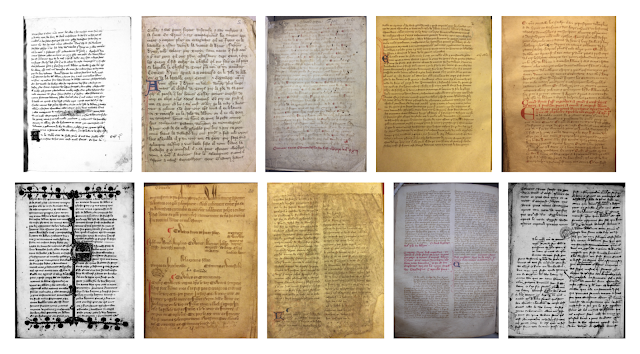
The Long Anglo-Norman Prose Brut manuscripts, from left to right, first row: 1. Aberystwyth, National Library of Wales, MS 5028C; 2. Cambridge, University Library, MS Ii VI 8; 3. Dublin, Trinity College, MS 501; 4. London, British Library, MS Add 18462; 5. London, British Library, MS Royal 20 A III; second row: 6. London, British Library, MS Cotton Cleopatra D III; 7. London, British Library, MS Royal 20 A XVIII; 8. London, British Library, MS Royal Appendix 85; 9. Oxford, Bodleian Library, MS Ashmole 1804; 10. Paris, Bibliothèque Mazarine, MS 1860. Not pictured: Intermediate (?), Lincoln’s Inn, Continental, and Tiberius versions.
*click here for a larger image*
Besides the main texts there are several continuations and variant versions that have yet to be properly studied. The Short and Long ANPBs received further continuations in Anglo-Norman, only one of which has been edited. The so-called Anonimalle Chronicle continues a peculiar expanded section of the Short ANPB, which has also been edited, but cannot be taken as a representative text. One copy of the Short ANPB and another three copies of the Long ANPB (all independent, perhaps adapted from a single insular copy) are in continental French, with changes made throughout that deserve further scrutiny. There are many other versions of the main text as well, including two peculiar abridgments of the Long ANPB.

The Anglo-Norman Prose Brut continuation manuscripts, from left to right: 1. Leeds, University Library, MS Brotherton 29; 2. London, British Library, MS Cotton Tiberius A VI; 3. New Haven, Yale University Beinecke Library, MS 86; 4. New Haven, Yale University Beinecke Library, MS 593; 5. Oxford, Corpus Christi College, MS 78.
*click here for a larger image*
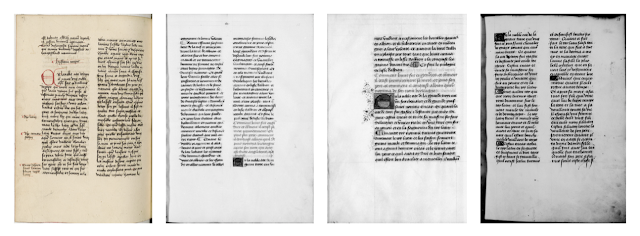
The Anglo-Norman Prose Brut continental manuscripts, from left to right: 1. Paris, Bibliothèque de l’Arsenal, MS 3346; 2. London, British Library, MS Royal 19 C IX; 3. Paris, Bibliothèque nationale de France, MS fr. 12155; 4. Paris, Bibliothèque Sainte-Geneviève, MS 935.
*click here for a larger image*
The Short ANPB (with prologue, presumably the second recension) was later translated (and abridged a bit) into Latin to form the first part of a four-part chronicle, the final two of which are known as the Canterbury Chronicle (or, Anonymous of Canterbury’s chronicle). This version of the Brut only goes to 1326 and, while it is tempting to presume that this was translated from the one copy of the Short ANPB that ends in the same year (Cambridge, University Library, MS Mm I 33), the transmission here requires further study. A manuscript of the second recension of the Long ANPB was translated into Middle English towards the end of the fourteenth century and soon received a continuation to 1377. This initial Middle English version only survives in a few manuscripts and likewise needs to be studied in more depth, especially in relation to its Anglo-Norman source. It has been presumed that a particular copy of the Long ANPB (London, British Library, MS Cotton Cleopatra D III) was the source because it has the same chapter divisions, but a word-for-word comparison of the MEPB with the Long ANPB shows this to be unlikely.

The Canterbury Latin Prose Brut manuscripts, from left to right: 1. London, British Library, MS Cotton Julius B III; 2. London, Lambeth Palace Library, MS 99; 3. Oxford, Magdalen College, MS Lat. 200; 4. Reigate, Parish Church of St Mary Cranston Library, Item 1117.
*click here for a larger image*

The Middle English Prose Brut (Common Version–1333) manuscripts, from left to right, first row: 1. Aberystwyth, National Library of Wales, MS Peniarth 398D; 2. Dublin, Trinity College, MS 490; 3. London, British Library, MS Harley 3945; 4. London, Society of Antiquaries, MS 93; 5. Manchester, Rylands Library, MS Eng. 103; second row: 6. Manchester, Rylands Library, MS Eng. 206; 7. New Haven, Yale University Beinecke Library, MS 494; 8. Oxford, Bodleian Library, MS Bodley 840; 9. Oxford, Bodleian Library, MS Douce 323; 10. Oxford, Bodleian Library, MS Rawlinson B 171. Not pictured: New York, Private Collection of J. D. Gordan, MS 63 (unavailable).
*click here for a larger image*
So, as you can see, from the Short and Long ANPBs sprung a wide variety of continuations, translations, and further continuations and translations. Indeed, the genre found wide popularity, thanks in no small part to its clearly political blending of mythology and history to establish England’s claim over all of Britain. Many pseudo-Brut chronicles were also written, some crafted from existing chronicles and others written more or less from scratch, all of which took on the general form of the Brut: a chronicle starting with the founding of Britain that methodically traces the line of rulers down to the (then) present day.[10]
It is therefore important for the Short and Long ANPBs to have their traditions sorted out and to receive proper editions (and thus allow work on variant versions, continuations, and translations to go forward). Since 2015 the British Library and more and more institutions, thankfully, now allow personal photography, which makes this sort of work more tenable than it was back in the days of pencils, notebooks, and microfilms (oh my!) While there are many more unedited and unknown chronicles from the period written in Latin, none are in the same level of detail, let alone with such a large readership, as the Short and Long ANPBs. The dearth of published Anglo-Norman history writing in the fourteenth century, combined with the almost total editing of all Middle English historical literature, has encouraged people to consider language, national identity, and the medieval understanding of the past in the later Middle Ages in a skewed fashion. This has obvious implications in many other areas of medieval studies.
I first came across the Brut and, in particular, the ANPB during my doctoral studies (2013–17). I was trying to perform a comprehensive examination of the historical literature written during the reign of Edward III (1327–77) so that I could arrive at a full(ish) understanding of attitudes towards various contemporary events at the time. I was shocked to find that the Short and Long ANPBs, such obviously important texts as they were, remained without proper editions (I was later more shocked to find so many other valuable chronicles unedited and almost entirely unknown!) I then sought to understand the dissemination and intended uses of these texts by listing the manuscripts and their contents. This led to further nightmarish yet rewarding research, which soon spiralled out of control despite the best efforts of my supervisors. All the while I kept thinking about, and doing little bits of work on the ANPB tradition, as it was the only one of my unedited texts for which the tradition remained unresolved. In the end I examined 303 manuscripts, almost all in person, visited 35 manuscript libraries, and wrote a 61-page appendix to my thesis. Indeed, probably 90% of this work on manuscripts and my appendix had absolutely nothing to do with the argument of my thesis, but rather stemmed from a desire to understand what was written and how the different versions of each text related to each other. This work has helped me move my research in new and interesting directions that I never would have considered had I not begun to examine the ANPB.
During my time at Aberystwyth and the Anglo-Norman Dictionary I was able to examine an important copy of the Long ANPB and other copies of the MEPB in the National Library of Wales. I was also able to discuss the above problems with Heather Pagan and Geerte De Wilde, editors of the Anglo-Norman Dictionary, both of whom have worked on different versions of the ANPB, and also make use of the excellent resources of the AND. The Anglo-Norman Dictionary scholarship allowed me to keep working on this difficult subject so that I could complete my PhD (and appendix). It has also provided me with invaluable resources to continue doing research on the difficult problem of the ANPB tradition.
I am currently preparing applications for three-year postdoctoral fellowships so that I can carry out and complete this project. My study of the Brut tradition and the three languages of England will disprove the common assertion that English identity only properly developed in the Middle English literary canon, especially from the late fourteenth century onwards. The outputs of the project will provide valuable insight into the development of the tradition and how it reflects ideals and attitudes towards the late-medieval world. Most importantly, however, it will allow critical editions of the various texts to finally be produced, and also help the ANPB to retake its place amongst the key writings of late medieval England.
Trevor Russell Smith
University of Leeds
ego_chronicon@outlook.com
[1] Antonia Gransden, Historical Writing in England, 2 vols (London: Routledge, 1974–82), vol. 2. While Taylor discusses the Anglo-Norman writings in more detail, his work is more of a synthesis of his previous works than a reference work: John Taylor, English Historical Literature in the Fourteenth Century (Oxford: Clarendon Press, 1987).
[2] Ruth J. Dean and Maureen B. M. Boulton, Anglo-Norman Literature: A Guide to Texts and Manuscripts, Anglo-Norman Text Society, Occasional Publications Series, 3 (London: Anglo-Norman Text Society, 1999), pp. 1–65.
[3] A Manual of the Writings in Middle English, 1050–1500, ed. by Burke J. Severs, Albert E. Hartung, and Peter G. Beidler, 11 vols so far (New Haven: Connecticut Academy of Arts and Sciences, 1967–), vol. 8.
[4] See n. 5 below.
[5] For texts cited in the diagram see ‘Anonymi chronicon Godstovianum’, in Guilielmi Roperi vita D. Thomae Moriequitis aurati, ed. by Thomas Hearne (Oxford: Veneunt apud editorem, 1716), pp. 180–246; Robert of Avesbury, ‘De gestis mirabilibus regis Edwardi tertii’, in Adae Murimuth; Robertus de Avesbury, ed. by Edward Maunde Thompson, Rolls Series, 93 (London: Eyre, 1889), pp. 279–471; The Brut, or the Chronicles of England, ed. by Friedrich W. D. Brie, Early English Text Society, Original Series, 131, 136, 2 vols (London: Paul, 1906–08); The Anonimalle Chronicle, 1333 to 1381, from a MS Written at St Mary’s Abbey, York, ed. by Vivian H. Galbraith, rev. edn (Manchester: Manchester University Press, 1970); The Anonimalle Chronicle, 1307 to 1334, from Brotherton Collection MS 29, ed. by Wendy R. Childs and John Taylor, Yorkshire Archaeological Society, Record Series, 147 (Leeds: Yorkshire Archaeological Society, 1991); The Oldest Anglo-Norman Prose ‘Brut’ Chronicle, ed. by Julia Marvin (Woodbridge: Boydell, 2006); Canterbury Anonymous, Chronicon: Chronicle, 1346–1365, ed. by Charity Scott-Stokes and Chris Given-Wilson, Oxford Medieval Texts (Oxford: Clarendon Press, 2008); Prose Brut to 1332, ed. by Heather Pagan, Anglo-Norman Text Society, Annual Texts, 69 (Manchester: Manchester University Press, 2011); ‘The Anglo-Norman Prose Chronicle of Early British Kings, or the Abbreviated Prose Brut: Text and Translation’, ed. by Heather Pagan and Geert De Wilde, Medieval Chronicle, 10 (2015), 225–319.
[6] Friedrich W. D. Brie, Geschichte und Quellen der mittelenglischen Prosachronik ‘The Brute of England’ oder ‘The Chronicles of England’ (Marburg: Friedrich, 1905); Lister M. Matheson, The Prose ‘Brut’: The Development of a Middle English Chronicle (Tempe: Medieval & Renaissance Texts & Studies, 1998); Julia Marvin, The Construction of Vernacular History in the Anglo-Norman Prose ‘Brut’ Chronicle: The Manuscript Culture of Late Medieval England (Woodbridge: York Medieval Press, 2017).
[7] Pierre de Langtoft, Le Règne d’Édouard Ir: Édition critique et commentée, ed. by Jean Claude Thiolier (Créteil: C.E.L.I.M.A., Université de Paris XI, 1989).
[8] Two MSS end at 1307, but the first of these is an abridged early version of the Long ANPB and the latter of these is a peculiar version of the Short ANPB: Cambridge, University Library, MS Ee I 20; Oxford, Corpus Christi College, MS 78.
[9] One MS of the Long ANPB has been transcribed, but it is not from a representative MS, is not compared to any of the other MSS, and has many errors throughout: ‘The Anglo-Norman Prose Brut: An Edition of British Library, MS Cotton Cleopatra D III’, ed. by Marcia Lusk Maxwell (unpublished doctoral dissertation, Michigan State University, 1995).
[10] See for example how Tyson unhelpfully lumps both pseudo-Brut and Brut-proper manuscripts together: Diana B. Tyson, ‘Handlist of Manuscripts Containing the French Prose Brut Chronicle’, Scriptorium, 48 (1994), 333–44.
An introduction to concordances (now with added violence)
Edward Mills is a PhD student at the University of Exeter, and — like David, our previous author — was a recipient of a bursary from the AND and the Arts and Humanities Research Council to support research at the Dictionary’s offices. In this guest blog post, he offers an insight into how he spent his two weeks.
————
E quant l’enfant fust de set anz, si le manderent a Joce de Dynan pur aprendre e noryr, quar Joce fust chevaler de bone aprise.
And when the child was seven years old, they gave him to Joce of Dinan to be taught and brought up, since Joce was a knight of great learning.1
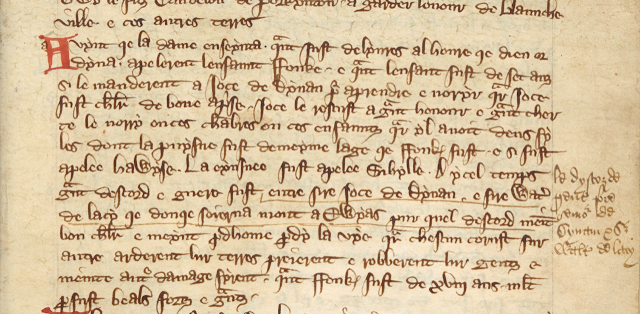
London, British Library, MS Royal 12 C XII (fol. 36r). Spot the reference to ‘aprendre e noryr’!
You’re seven years old. You didn’t sleep well last night — even an aristocratic family like yours, after all, isn’t immune from the winter chill — and you shiver slightly as you rise and go to rub the sleep from your eyes. Then you remember what your father told you the previous evening: that today was going to be different. From today onwards, you’ll be staying up the valley, and wise knight Joce, to … to …
… to what? This passage, taken from early in the Anglo-Norman ‘ancestral romance’, Fouke le Fitz Waryn, certainly allows us to conjure a vivid image of the young title character at the moment of his departure from his parents, but it’s far less useful in understanding what young nobles like Fulke would have done after leaving their families behind. What exactly would Fouke, taken away from his household at the age of seven, have expected to gain from his time in the household of Joce of Dinan? All that the Anglo-Norman text really tells us is that Joce was expected to ‘aprendre e norir’ the seven-year-old Fouke; shortly afterwards; we get the briefest of hints about what this might involve, when we are told that Joce ‘le nourry en ces chambres ou ces enfaunz’ (‘brought him up in his household with his own children’). That’s still not all that much to go on, though, especially given that the Anglo-Norman Dictionary defines both apprendre and norrir as ‘to bring up, to educate’, making, for both words, reference to precisely this passage. Why, then, would our 14th-century author have used both of these terms if they were synonyms of one another? There’s certainly an element of stylistic doubling going on here, as well as doubtless some semantic overlap, but do the terms aprendre and norir, along with other Anglo-Norman ‘verbs of education’, really map onto one another quite that easily?
These are some of the questions that I’m trying to answer in my PhD. In the interests of full disclosure, I should probably mention that my PhD isn’t actually on the subject of Fouke le Fitz Waryn: he texts that I’m looking at are far more overtly didactic in nature, often devoid of a narrative and displaying a forthright desire to instruct their audiences from the outset. Examples from narrative literature such as Fouke, though, do illustrate the semantic slipperiness of much medieval French terminology in the area of education. When an Anglo-Norman author uses a term such as aprendre or enseigner in a prologue to a didactic text, what kind of ‘education’ does this term imply? What, in short, can the words that Anglo-Norman scribes used tell us about vernacular understandings of instruction?
Questions in this broad research area are at the heart of my PhD, which looks at a range of Anglo-Norman didactic texts to address how education was imagined and enacted through French in post-Conquest England. Looking specifically at word choice, though, brought me into contact with something that I’d not really worked on before: historical lexical semantics. This discipline combines the study of word meaning with an interest in how languages change over time, and during my two weeks at the AND, I’ve been making use of its unique resources, many of which tie in directly to the AND staff’s own research interests in semantics and lexicography. In this blog post, I’d like to offer a brief introduction to one of them: concordance software, or more specifically, how a piece of very 21st-century technology can help us to understand the world-view of a mid-14th-century scribe.
The primary function of concordance software is — well — producing concordances. Full ‘concordances to a text’ are fairly simple in theory: they’re essentially just a listing of every instance where each word appears within that particular work, arranged in alphabetical order. They’re used for all kinds of work in linguistics, but have traditionally been very laborious to produce. For one thing, they’re (by definition) many times longer than the original works themselves; if someone were to produce a full concordance to Fulke, for instance, the sentence with which this post began would appear on something like ten separate occasions, one for each of enfant, anz, manderent, and so on. (Mercifully, function words like e and quant tend to be omitted.) To give an idea of just how terrifying printed concordances can be, here’s a snapshot of one page from the Concordance to the French Poetry and Prose of John Gower, which the AND rather handily had on the shelves in the office:
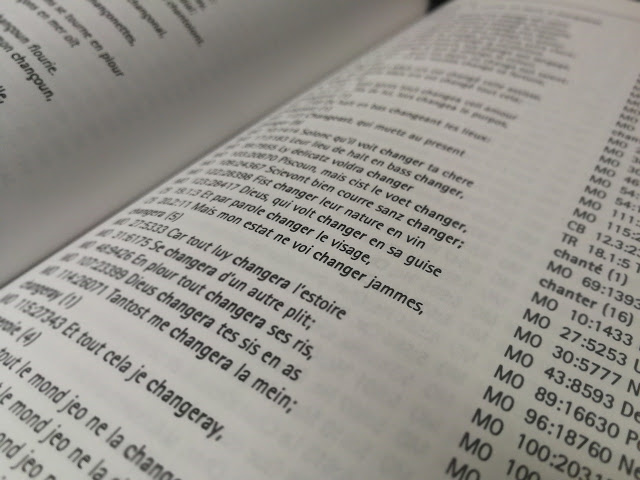
Most people using concordances, of course, won’t need to refer to every single word in the text; instead, like me, they’ll be looking at a handful. This is where concordance software such as what the AND uses comes into its own: producing a ‘limited’ concordance, which only searches for instances of a single string of characters across a corpus, can be done very quickly by dedicated programs, as these can plow through millions of words of Anglo-Norman set out in .txt format. Richard Ingham, for instance, has established a concordance of Anglo-Norman noun modifiers — cel(e), cest(e), nul(e), tut(e) — in order to investigate whether or not gender marking of noun modifiers is retained in later Anglo-Norman. By looking at the context to these words en masse, made possible by the way in which the concordance software arranges its material, specifically the nouns that they refer to, it becomes possible to infer whether ‘incorrect’ renderings (along the lines of *cel chose, *ceste munde) is as frequent as one would expect them to be, if the descriptions of later Anglo-Norman as ‘decadent’ are to be believed. (Spoiler alert: they aren’t.)2
My interests, though, are less grammatical and more semantic: I’m less interested in the precise realisations of a given lexeme than the various meanings that are ascribed to it across Anglo-Norman texts. With work like this, the concordance isn’t a magic bullet: just looking at the immediate context of a word won’t tell me everything I need to know about how it was understood. I therefore need to take a look at the broader context — usually around ten lines either side of the word I’m looking for — in order to gain a firmer handle on is meant by a particular use of (say) chastier. Thankfully, concordance software is still useful in this respect, as it can show me precisely that in a separate window — and if I really want to consult the print version, I can always fall back on the extensive library of texts available at the AND.

While I’m using a separate piece of software here — CasualConc 2.1, for the curious, thanks to its offline functionality — the AND has almost exactly the same functionality available, in a very user-friendly yet powerful online interface. Concordances of particular strings can be created both out of the Anglo-Norman Textbase (which currently includes over 70 texts from the twelfth to the fifteenth century) and from all of the citations that make up the entries in the Dictionary itself. Over the two weeks I spent at the AND, I had enormous fun probing the possibilities of concordance searching, which caters from simple string-searches all the way up to comprehensive support for regular expressions (for the real nerds out there), and cataloguing the various ways in which specific verbs of education are employed. Among the results for a search of norrir, of course, can be found a single instance of a double-verb sub-clause that offers the tiniest glimpse of what education meant to authors of prose romances.

Don’t worry about Fulke, by the way. His education turns out all right in the end — all right enough, anyway, for him to be saving Joce de Dinan’s life (two pages and 11 years later) and slicing enemies in two. Perhaps we should be grateful that that particular facet of Anglo-Norman education hasn’t survived into the modern curriculum.
————
Edward is a PhD student at the University of Exeter. During his time at the AND, he shared out a series of ‘fun facts’ about the AND, which you can read on his Twitter profile.
———
1 E. J. Hathaway, P. T. Ricketts, C. A. Robson and A. D. Wilshere (eds.), Fouke le Fitz Waryn (Oxford: Anglo-Norman Text Society, 1975), p. 10.
2 Richard Ingham, ‘Final -e loss in insular french: Exploring the Anglo-Norman Hub Textbase’, in Past and Future Research in Anglo-Norman: Aberystwyth Colloquium, July 2011, ed. by David Trotter (Aberystwyth: The Anglo-Norman Online Hub, 2012), pp. 69-77. On perceptions of later Anglo-Norman as ‘decadent’, see Ian Short, ‘L’anglo-normand au siècle de Chaucer : un régain de statistiques’, in Le plurilinguisme au Moyen Âge, ed. by Claire Kappler and Suzanne Thioller-Mejean (Paris: L’Harmattan, 2009), pp. 67-77.
Writing Morality in the Anglo-Norman World
Davide Battagliola, post-doctoral researcher from the University of Milan visited the Anglo-Norman Dictionary project for 4 weeks in July-August 2018 – thanks to a bursary from the AND and the AHRC (Arts and Humanities Research Council). During this period, he was able to continue his research in Aberyswyth, making use of the materials, resources and expertise of the AND team.
He writes the following blogpost on his project.
We can find a high number of continental manuscripts transmitting the Livre de Moralitez. This French translation of William of Conches’ Moralium Dogma Philosophorum achieved a remarkable success throughout Europe during the Middle Ages; yet, little did we know about the circulation of this moral treatise in medieval Britain.
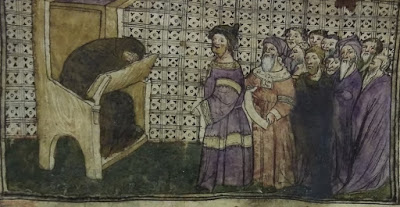
The treatise opens with the author falling asleep and being visited in his dream by ancient philosophers and writers (miniature taken from the ms. Torino, Biblioteca Nazionale Universitaria, L.III.14)
In his 1929 edition, John Holmberg already pointed out how the manuscript K (Paris, BnF, fr 25407), the only Anglo-Norman witness, offered a remarkably different text than the version widely read on the Continent. Whats’s more, K appeared to provide a more reliable version of the work. One may ask why Holmberg did not use this manuscript to establish his edition, but we all know that back in the 1920s the Anglo-Norman language was still considered nothing more than the faux français d’Angleterre…
The Swedish scholar also supposed the existence of a common source for the manuscript K and Paris, BnF, 1822 (= L), which transmits an abridged form of the treatise. Traditionally thought to be produced in Wallonie, L was copied by Servais Copale. In his latest monograph, Keith Busby affirms that the scribe operated in Ireland, a statement which would in fact need further study. But, regardless of its geographical provenance, the manuscript L undoubtedly exhibits an interesting mixture of both Anglo-Norman and Walloon traits. Moreover, Holmberg was not aware of the existence of another insular witness, that is Cambridge, Corpus Christi College Library, 405 (Cc).
During my staying at Aberystwyth – funded by a bursary from the Anglo-Norman Dictionary together with the AHRC – I had the opportunity to study these three manuscripts from a textual and linguistic point a view. It has been of particular interest to focus on the lexical peculiarities of this version. Take for example the following sentence about the virtue (!) of cruelty:
La tierce meniere de cruaté est de chacier hors des genz les larrons, les ocianz et touz cels qui mainent tel meniere de vie, car il ne font a soffrir en compaignie de genz
(The third kind of cruelty is to chase away thieves, murderers and all those who lead such kind of life, as they are not to be tolerated in the community)
Whereas the Continental version uses the form ocianz, manuscripts K and L read homicides; interestingly enough, Cc chooses the otherwise unattested form murdrerus (cf. AND entry murdrier).
An analysis of the context of K and Cc also allowed me to explain the occasional presence of sentences drawn from the Bible, one of the most striking feature of the Anglo-Norman redaction. In a treatise mostly composed of quotes by great men of the Antiquity, such as Seneca and Cicero, these biblical insertions can be attributed to the influence of monastic Orders: indeed, the codex Cc belonged to the Hospitaller brethren of Saint John of Jerasulem in Waterford; as for L, the scribe Servais Copale worked in harness with the Hiberno-Norman Dominican author Jofroi de Waterford.
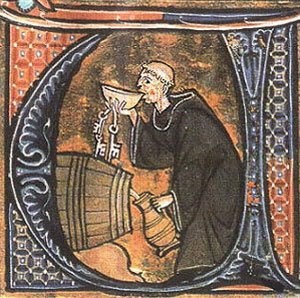
BnF fr. 1822 also transmits Jofroi de Waterford’s adaption of the ‘Secretum Secretorum’. This version contains a curious section devoted to the different vareties of wine
Once again a comparison with the continental version is of great interest. In Holmberg’s edition we read:
Li membre de felonie si sont paors, auarice et couoitise. Paors est quant ·i· hons viaut nuire a ·i· autre et il a paor, si nel fait, qu’il i ait domage.
(The parts of felony are fear, greed and covetousness. Fear is when a man wants to harm another one and he is afraid of having a damage if he does not do that)
The insular witnesses replace paors with peresce (‘lazyness’). No wonder that, within the cold walls of a cloister, a monk could indulge from time to time in the sweet temptation of staying in bed until late! Of course the Anglo-Norman Livre de Moralitez gives a nicer ring to it:
Peresce si est qant hom devient lent et parceus de ben fere pur pur (sic) pour de terrene damage.
(Laziness is when someone becomes slow and lazy in doing good deeds because he is afraid of wordly damages)
Were these insertion a mean to counterpoint the mundane, maybe too secular, nature of William of Conches’ compendium? It is just one of the many questions arising from this fascinating Anglo-Norman adaptation of the Livre de Moralitez.
Announcement: Bursary for study of Anglo-Norman
The Anglo-Norman Dictionary (www.anglo-norman.net), an AHRC funded project held at Aberystwyth University, would like to invite expressions of interest in a post-graduate bursary fund supporting research on Anglo-Norman.

Aberystwyth Univeristy, Old College
(image taken from http://sirgarblog.blogspot.co.uk/2013/07/redevelopment-of-aberystwyths-old.html)
Over the next four years, five bursaries, of up to £1000 each, will be available to support post-graduate students and their research on projects related to Anglo-Norman. Applicants will be able to make use of the considerable resources available at the Dictionary office, including editions of Anglo-Norman works as well as a vast library of works on Anglo-Norman, Romance linguistics, etymology and lexicography. As visiting scholars at Aberystwyth University, applicants will also be able to make use of the university library as well as that of the National Library of Wales. Applicants may be asked to give a short research presentation to the department or write a blog post about their research.
The bursary is intended to be used towards the cost of travel and accommodation in Aberystwyth. Applicants should submit a short description of their research for consideration as well as a summary of potential expenses.
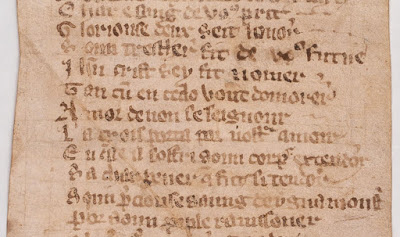
Excerpt from MS Aberystwyth, National Library of Wales, Bettisfeld 18
Expressions of interest and any questions should be directed the editors, Dr Geert De Wilde and Dr. Heather Pagan at anglonormandictionary@gmail.com by December 1st, 2017, for travel in 2018.
Anglo-Norman and Sound Art
Describing the meaning and semantic range of Anglo-Norman words has always been, and still is, the primary function of the Anglo-Norman Dictionary. However, the online AND (www.anglo-norman.net) also provides material, tools and research possibilities for medievalists, linguists and many other disciplines. When Dr. Alan Chamberlain, Senior Fellow in the Department of Computer Science of the University of Nottingham, visited us last week, to talk about a new and exciting project he proposes between his Mixed Reality Lab (University of Nottingham) and the Anglo-Norman Dictionary, the cross-disciplinary potential of online AND resources was clearly central to his ideas.
Dr. Chamberlain explains his views on scholarly innovation through incorporating Anglo-Norman and the AND in his Experimental Digital Humanities and Sound Art:
Funnily enough I’d been reading a book on medicine in medieval society and had come across the Anglo-Norman word mire referring to a specific sort of medical practitioner. I’d looked up and come across the AHRC funded Anglo-Norman Dictionary project, and I’d met the Principal Investigator (Dr Geert De Wilde) previously at a Digital Humanities conference and a Sound Art symposium. So I thought I’d get in touch.

Dr. Geert De Wilde (AND) and Dr. Alan Chamberlain (University of Nottingham)
As someone who researches HCI (Human Computer Interaction) archives, their building and design are interesting, but I think that the Dictionary is much more than an archive, it’s a great resource that goes beyond mere semantics, and provides a resource for anyone that wants to engage with and use the content that they hold and work with. Currently I lead the Design and Performance strands of the EPSRC funded FAST Project http://www.semanticaudio.ac.uk, so it was interesting to see how the dictionary dealt with semantics and sound from a historical perspective. It’s not difficult to see how this might be developed in the future, as another strand of the dictionary.
I’m currently working on developing an immersive opera-based experience with the Finnish composer Maria Kallionpää, and in August I performed a work that I’d been developing with Prof Dave De Roure and Pip Willcox, from the University of Oxford and Bodleian Library, based on Ada Lovelace. Our investigation and experiments started to form a methodology that we called –‘Experimental Digital Humanities’. The performance can be found here:
The Gift the Algorithm: Beyond Autonomy and Control (Live)
I’ve just started to look at working with the Anglo-Norman Dictionary Project and using their content and expertise to inform another piece that I have started to mentally sketch out, and I would like to work more with them in the future. I already have a pile of references and notes – both on Anglo-Norman medicinal sources and on semantic fields within the dictionary of ‘sound’ (cf. their extremely useful ‘Search by semantic or usage labels’ option) from the visit.

The research that is funded in the UK is of international importance and really does offer people the chance to work together to explore and create innovative and impactful experiences that wouldn’t normally happen.
– Dr Alan Chamberlain (note the Anglo-Norman Dictionary entry on his name!) is a Senior Fellow in the Department of Computer Science (Mixed Reality Lab), University of Nottingham, a visiting Academic at the University of Oxford, and a Fellow of the Royal Society of the Arts.
AND site update: Search by semantic tag
The revised semantic labeling system
Already in the first published fascicle of AND1 (back in the late 1970s), the English definitions sometimes were given a semantic category label. For example, sub abatre1, the sense ‘to abate, put an end to’ was labelled ‘(law)’ and the sense ‘fir tree’ sub abiet had the label ‘(bot.)’. These bracketed items served to clarify the semantic context, identifying the first example as a legal term and the second as belonging to the semantic domain of botany.
However, even in the first phases of the AND2, no clear editorial policy, let alone statement, existed about what labels should be used, where or why. In practice these labels (eccl., orn., med., nav., culin., arithm. etc.) were inserted ad hoc, as and when an individual editor thought it would clarify a definition. As a result, such labels as were present were seriously inconsistent.
(For further discussion of this, see Geert De Wilde, ‘Re-Considering the Semantic Labels of the Anglo-Norman Dictionary’, in: David Trotter, Present and Future Research in Anglo-Norman: Aberystwyth Colloquium, July 2011, Aberystwyth, The Anglo-Norman Online Hub, 2012, pp. 143-50; available for download on https://aber.academia.edu/GeertWilde).
As a major ‘deliverable’ of the AHRC award which funded the revision of letters N to Q between 2012 and 2017, the labeling of entries was completely re-thought and re-implemented A-Z. A more comprehensive and clearly defined set of 105 semantic labels was established, drawing on but also extending and rationalizing those already AND, and on semantic systems applied by the OED, the HTE and the disciplines used in TLF.
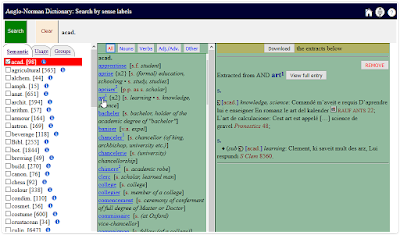
The outcome is a searchable semantic network underlying the dictionary definitions, which will be extended and refined as the revision of entries progressively adds new material, and as earlier sections of the AND are reworked. Further labels may be added and others may still be adjusted. However, as it is, the present system provides solid information and a reliable outcome that, for the first time, enables AND-users to study and investigate the Anglo-Norman language from a semantic perspective.
Searching the labels
The brand new label searching interface can be entered either from its link on the site home page (‘Search by semantic or usage labels’), or from the dictionary’s entry-browsing interface, using the ≡ icon, near the top right of the screen.
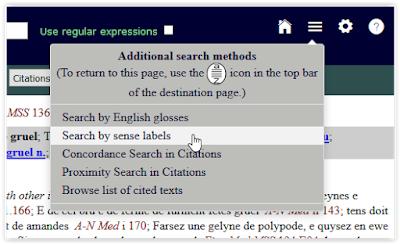
The label searching interface opens. In the left-hand area is an alphabetical list of the semantic labels. [A second tab in that area lists Usage labels (i.e. labels that do not indicate semantic areas, but ‘usage’, such as ‘ironic’, ‘curse’, ‘euphemism’ ‘figurative’), and a third one Groups of labels, which are in effect pre-selected multi-label queries which automate and combine some of the separate steps for building a label query, which are described below)].
The ‘info’ symbol displays explanatory information (in the second column) about how exactly each label is defined, with, in some cases, hints about possible alternative or additional labels.
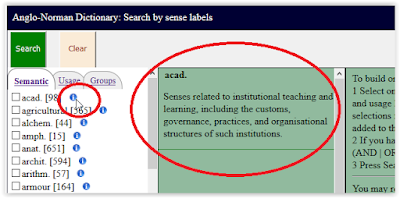
Highlight one or more labels, click ‘search’, and all entries with there relevant senses will appear in the second box.

Click on any blue headword, and the third column will show a fuller extract from the entry concerned, comprising the part(s) of speech of the labelled sense(s) and the actual sense itself, with its gloss and the attestation(s) attached to it, including their sigla and location reference.
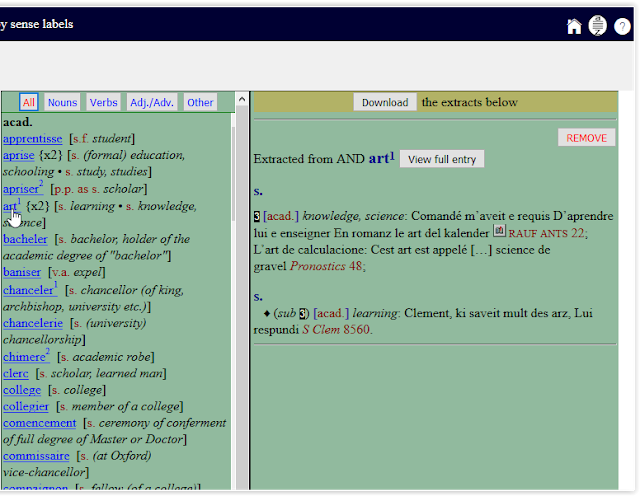
Multiple search terms and logical operators
You may select as many labels as you wish. Each time a dropdown-menu will appear between two selected labels offering the options ‘AND’, ‘OR’ and ‘NOT’.

The logical operator ‘OR’ retrieves every sense that has either of the labels concerned alone (as well as both of them together). ‘AND’ between two search terms produces a smaller number of results because both of the labels must be present on a given sense. Finally ‘NOT’ removes all instances of a given semantic tag (for example ‘weapons’ but NOT ‘military’).
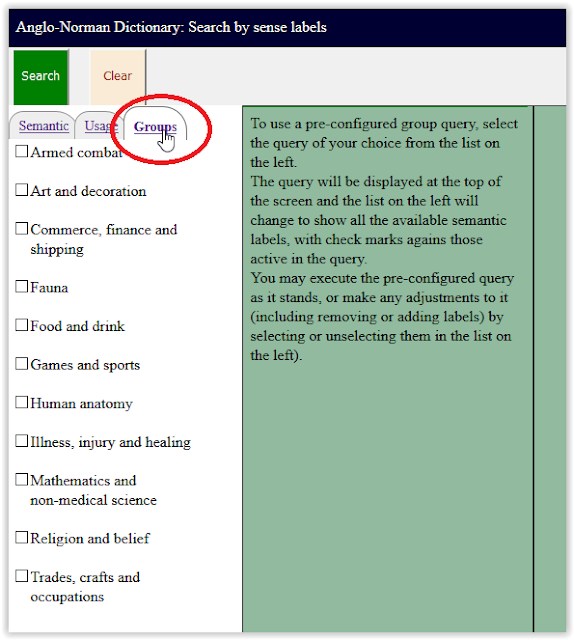
The most common group queries have already been added under the third tab in the first column of preconfigured ‘Groups’.
For example, the group ‘Fauna’ represents the string ‘amph. OR crustacean OR horses OR ich. OR insect OR mammals OR orn. OR rept. OR zool.’, and retrieves all Anglo-Norman lexis for animals. As with the other searches, further semantic tags can be added or removed. Furthermore, the results can be ‘pruned’, as all extracts in the right hand can also be removed individually. (They can always be restored by reselecting them in the central column).
It is possible to download the results of each search, by clicking on the ‘download the extracts below’ button: a file will be sent to your browser with the extracts concerned which you can then store and view locally.
AND site update: interface and layout
In the new updated version of the AND site (www.anglo-norman.net), there are now various ways of adjusting the way an entry is displayed and, to a certain extent, to customize the dictionary’s interface.
- Font size. You can enlarge or reduce the font size of displayed entries using the A+ and A- buttons on the button bar near the top of the screen.
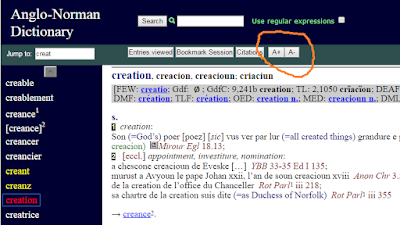
- Hide citations. You can hide or reveal the citations in a displayed entry using the ‘[SHOW/HIDE] Citations’ button, also on the button bar. Particularly in longer entries, this option may be useful to get a quick overview of the full semantic range of a word.
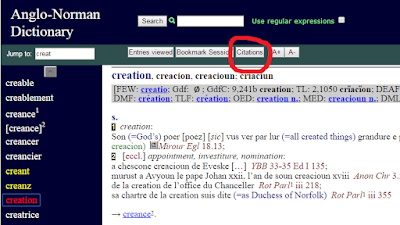
It has to be noted that unlike the ‘sense boxes’ already available for a while in longer entries, this new feature includes a) all of the semantic tags and b) all locutions and their senses.
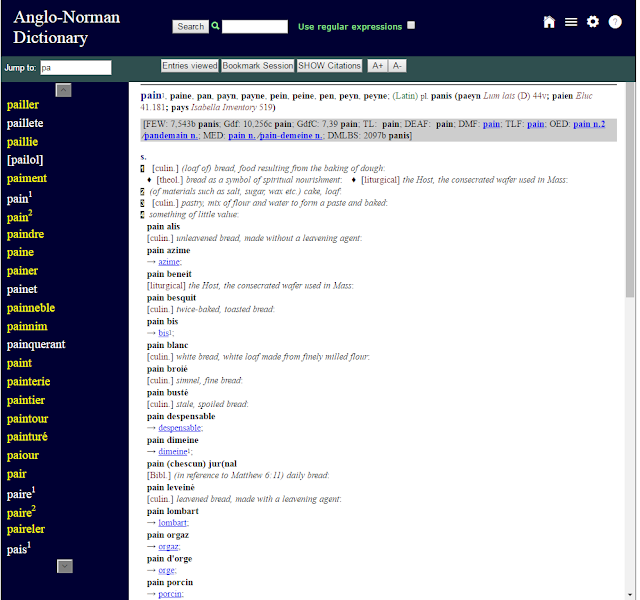
- Display layout. Using the “gear wheel” setting icon at the top of the screen you can choose between three display layouts for the entry: “Compact”, roughly equivalent to the previous standard layout, or “Normal” or “Expanded” which add progressively more white space and line-breaks between entry components. These layout settings “stick” for the remainder of your session unless you choose to change them.
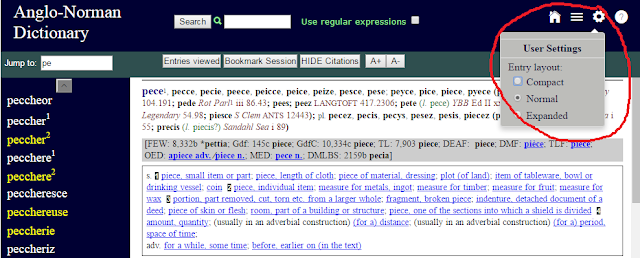
Older features remain active and may be worth reminding of:
- Expand the reference. If you click or tap on any reference siglum following a citation, bibliographical information for that siglum will appear in a small window of its own.
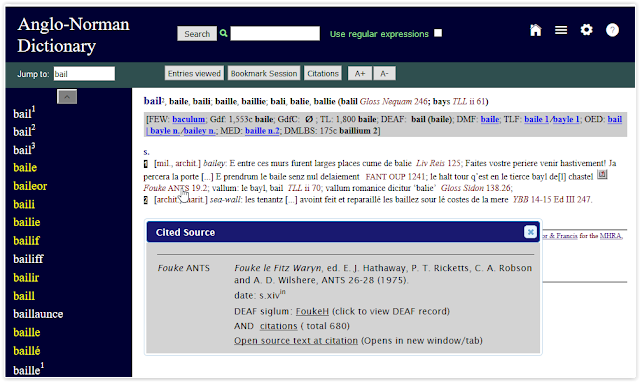
- Look up any word in any citation. If you double-click on any Anglo-Norman form within a citation, the server will send back, in an overlaid window, the results of looking up the form you have double-clicked on in the Dictionary, followed by a list of all the citations in which that form occurs. (This feature does not work on tablets or touchscreen devices.)
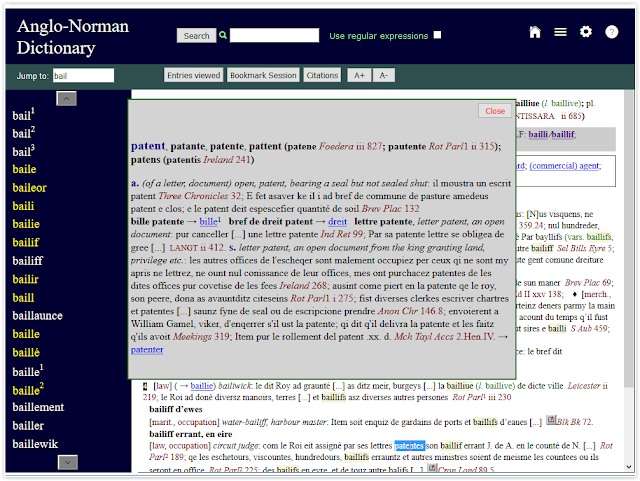
- Get a list of consulted entries. The server maintains a list of the entries you have consulted, either by choosing them from a pick list, or by following cross references within entry bodies, for as long as your session lasts. (Your “session” generally comes to an end when either close down your browser, or load a completely different site into the tab or window you have been using to view the AND). In the button bar near the top of the main browsing interface, you will see a link labelled “List entries visited”. Clicking this link will cause whatever wordlist you have displayed to the left of the screen to be replaced by a list of the entries you have viewed so far.
The site has been redesigned to be fully usable on Apple Ipad devices, including the Ipad Mini 2 and later. Some Android-based tablets will also give satisfactory results, but there is too much variability among Android devices to support them comprehensively. It is also not practicable within the project’s current budget to make all the features of the Dictionary usable on mobile telephones. However for occasional use to look up A-N words where no other device is available, the main browsing / searching interface (though not other portions of the site) will adapt to the dimensions of a phone-sized display, enabling the main facilities of that interface (the scrolling wordlist and the search by free-form entry).
AND site update: search options
Last week, the lay-out and presentation of the online AND [http://www.anglo-norman.net] was updated (for the first time since it was opened to the public back in 2006!), making it compatible for use on computers, tablets or handheld devices and adding new features. In the next couple of blog-posts, we will talk you through some of the possibilities and changes.
One immediately striking difference is that the main AND page now has two search boxes – two main ways of accessing entries in the dictionary.
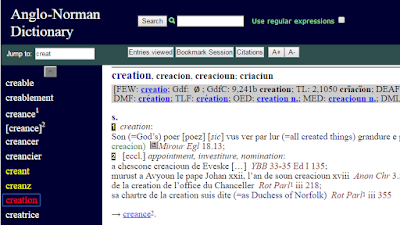
- Use ‘jump to’ for browsing the alphabetical list of headwords.
At start-up, the left-hand area of the screen shows a segment of the headword list starting with the first entry. As before, forms in white link directly to a substantive entry. Forms in yellow indicate a cross-reference headword, and lead automatically to the referenced substantive entry or entries. Click or tap on a headword to fetch the entry into the main area of the screen.
You can alter the point at which the wordlist begins by typing one or more letters into the “Jump to” box just above the list. For example, tapping or clicking in the “Jump to” box then pressing the “g” key will move the wordlist to the first entry that starts with that letter.
You may type as many letters as you wish. If you type in a sequence of letters that is an AND headword, the list will be updated to start at that word. Otherwise, the list will start at the alphabetically closest match to whatever you typed in. You may then move through the wordlist by clicking or tapping the up or down arrow buttons above or below the list.
You can change the list start position at any time by typing into the “Jump to” box.
Please note that this is not intended as a search mechanism. If a given form is indeed an AND headword, this method will locate the entry concerned. But the AND contains many variant and/or inflected forms which do not figure as headwords, hence you will not find them by headword browsing. For a thorough search, you should use the method described next.
- Use ‘search’ for entering a form to find a specific entry
If your search term matches any headword or variant form, or on any word that is recognized as an attested form of a headword item, you will see a list of the matched entries on the left, from which you can select entries to be displayed in the main area.
The list of matched entries will replace the standard alphabetic headword list on the display, but you can recover that list at any time using the RESTORE A-Z WORDLIST button above it.
By checking the box to the right of the input area you may ‘use regular expressions’ in your search term, i.e. search for parts of words: if you are unclear about what that means, please consult the full documentation.
In the next blogpost we will show you how, for the first time, you are now able to customize the lay-out and contents of any AND-entry.
WoM: Welsh words in Anglo-Norman
Last month, we discussed the presence of loanwords from Irish in Anglo-Norman, and this month, we would like to look further into the linguistic contact between Anglo-Norman and Celtic languages – this time focusing on Welsh. While there has been considerable research into the influence of (Anglo-)French on the Welsh language, particularly in the literary sphere, linguistic contact between the two languages in the administrative and judicial spheres remains relatively poorly studied[1].
Among the materials and sources used for the compilation of the AND we find two editions that bring together documents written in Wales by Welshmen: the Calendar of Ancient Correspondence Concerning Wales, and the Calendar of Ancient Petitions Relating to Wales. The former contains mainly records of correspondence between the English royal court and nobles in Wales, while the latter provides evidence of petitions from individuals throughout Wales to the English king. There are limitations to using these two works – they are primarily calendars, intended to discuss the contents of the document, and often do not include the text. Although hardly indicative of there ever being widespread levels of comprehension of Anglo-Norman in Wales, this documentation does suggest the presence of scribes, notaries or other public servants, in all parts of Wales, with a high level of linguistic competence in Welsh, Anglo-Norman and Latin.

(Aberystywth Castle)
Trotter’s examination of the above mentioned texts, supplemented with his own transcriptions of a limited number of documents in Welsh archives, unearthed twenty Welsh words used in Anglo-Norman context. Of these, nine are currently included as entries in the AND: amobres, commot, frith 3, havoterie, hildenraeth, keveretz, kymorthas, merchet 1 and obeduz. As with Irish, all of the loanwords occur in administrative documentation, and for Welsh, a great number of the terms refer to legal concepts.[2] There is currently no evidence of Welsh words being used in Anglo-Norman literary texts, though it is known that a number of Anglo-Norman works were composed or copied in Wales.
Some of the borrowing of Welsh legal terms seems to be driven by the need to refer to Welsh law – one document refers explicitly to the law of Howel the Good, and in the entry for keveretz we find:
aprés la conqueste de Galis lor graunta lor leis et lor usages q’il aveient […] la conqueste […] keveretz Howel les queiles eux et lor auncestres ount eou et usé RLiR 58 482 (National Archives SC 8/146/7288)
[‘after the conquest of Wales, he granted them their laws and their usages as they had [before] the conquest […] the cyfraith Hywel which they and their ancestors had and used’]
The word keveretz is intriguing, as it renders the Welsh cyfraith, ‘law, legislation’[3], but clearly reformulates it, not only adjusting the spelling, but even producing an Anglo-Norman plural.
The documents also refer to amobres, a term for ‘marriage fee’ from the Welsh amobrand obeduz (from Welsh ebediw) referring to ‘the rendering of a live beast to a lord at the death of a tenant’. A commot was a territorial and administrative division in Wales (Welsh cwmwd) and is attested in three different source texts in Anglo-Norman. The word was, from the end of the 12th century, present in Latin under the form commotus (DMLBS 397a) and from the 13th century, also present in English (see OED commot, n 37273) so it seems likely that the Anglo-Norman word is not a direct borrowing from Welsh.

Other Welsh words refer to the specific types of taxes owed by the local population: hildenraeth,[4] that is, a tax paid in oats, is likely derived from the Welsh hildaf ‘to produce (a certain amount of crop)’ and treth meaning ‘tax’ while kymorthas, from the Welsh cymorth, refers to a tribute of cattle owed to a lord, though the sole use of it in the Anglo-Norman citation below is ambiguous:
Item, qe nulls westours, et rymours, mynstrales, ou vacabundes, ne soient sustenuz en Gales, pur faire kymorthas ou quyllages sur le commune people, les queux par lour divinaciones, messonges et excitacions, sont concause de la insurrection et rebellion q’or est en Gales Rot Parl1 iii 508
[‘Item, that no wastrels and rhymers, minstrels or vagabonds, be sustained in Wales to receive tribute or money from the common people, who, by their divinations, lies and incitations are the root cause of the insurrection and rebellion that is currently in Wales’]
Legal terms are not the only type of borrowing from Welsh – a number of agricultural terms used by the local populations are also found in these texts. Frith is the equivalent of the Welsh ffridd, meaning ‘mountain pasture’, though the term ultimately derives from Old English (see OED frith,n.2). Havoterie ‘summer meadow’ derives from the Welsh hafod or ‘summer residence’ or ‘upland farm’.
A nostre seignur le Roy et a son consail monstrent ses povre gentz bondes de sa havoterie en le counté de Meyronnyth qe […] RLiR 58 482 (PRO SC 8/258/12874)
[To our lord the King and to his council we show the poor bondsmen of his summer meadow in the county of Merioneth that […] ]
Welsh borrowings slated to be added to the AND in the course of its present revision to the Second Edition, include the terms raglot, raglour and ragelotie. These all refer to the Welsh rhaglaw, that is, ‘vicegerent, viceroy, deputy’. The term raglot is equally attested in Latin from 1304 (DMBLS 2650a raglotus ‘ragler, chief officer of commot’ ) while raglour was equally used in Middle English, though the earliest citation of the word in the MED and OED is in an Anglo-Norman text (MED raglore n.; OED raglour n. 157484). The DMLBS (2649c) attests to the use of the form raglarius ‘ragler, chief officer of commot’ from 1485. Raglotia ‘office of ragler, raglership’ is attested from 1314 while raglaria is attested from 1334. It seems likely that these terms have entered Anglo-Norman through Latin.
La ragelotie de Cruthyn RLiR 58 483 (PRO SC 8/124/6154)
[The rhaglawry of Cruthyn’]
Ultimately, there are few identified borrowings from Welsh and Irish into Anglo-Norman, and those that are present are largely as a result of the borrowing of technical vocabulary in administrative documents. This may suggest a lower degree of contact between Welsh and Anglo-Norman as well as between Irish and Anglo-Norman than that between Middle English and Anglo-Norman. However, as Trotter emphasizes in his article, it is most certainly the case that Anglo-Norman documents from these areas remain less studied, and it may be that further investigations into the archival holdings in contacts zones in Ireland, Wales and Scotland may yield further evidence of language contact between the Celtic languages and Anglo-Norman.
[HP]
[1] We are indebted to the work done by Prof. David Trotter on the topic, particularly the article ‘L’anglo-français au Pays de Galles: une enquête préliminaire’, Revue de Linguistique romane, 58 (1994), 461-88. Trotter provides a summary of studies on the (Anglo-)French influence on Welsh on p. 462, note 2 of his article.
[2] That’s not to suggest that the writing of Anglo-Norman by Welsh individuals was restricted to the production of administrative material. As Trotter notes (p.461), Hue de Roteland, who wrote Ipomedon [Ipom BFR] and Protheslaus [Proth ants] was from Rhuddlan (Dyfed) and a Simon of Carmarthen composed Le Chemin de Penitence [Penit].
[3] We use here the headwords and definitions of the Geriadur Prifysgol Cyrmu (welsh-dictionary.ac.uk).
[4] It should be noted that this spelling has been rejected by the AND. The term should read hildevraeth.
